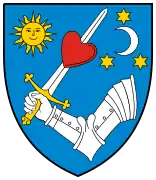Valea Crișului
Sepsikőröspatak | |
|---|---|
 | |
 Location in Covasna County | |
 Valea Crișului Location in Romania | |
| Coordinates: 45°55′N 25°46′E / 45.917°N 25.767°E | |
| Country | Romania |
| County | Covasna |
| Government | |
| • Mayor (2020–2024) | Sándor Kisgyőrgy[1] (UDMR) |
| Population (2021-12-01)[2] | 2,354 |
| Time zone | EET/EEST (UTC+2/+3) |
| Vehicle reg. | CV |
Valea Crișului (Hungarian: Sepsikőröspatak [ˈʃɛpʃikørøʃpɒtɒk]) is a commune in Covasna County, Transylvania, Romania composed of two villages:
- Calnic / Kálnok
- Valea Crișului / Sepsikőröspatak
History
It formed part of the Székely Land region of the historical Transylvania province. Until 1918, the village belonged to the Háromszék County of the Kingdom of Hungary. After the Treaty of Trianon of 1920, it became part of Romania. In 2004; the village of Arcuș split away from Valea Crișului to form an independent commune.
Demographics
The commune has an absolute Székely Hungarian majority. According to the 2002 census, it has a population of 2,185, of which 98.44% or 2,151 are Hungarian.
Points of interest
There is a historic Roman Catholic church at Valea Crișului. In its semicircular apse dating from the era of the Arpad dynasty, there are fragments of medieval frescoes considered to be of the 14th century. Its smaller bell was made in Brasov in 1512. The patronal feast of the church is on Trinity Sunday.
The ancestral castle of the family of Count Kálnoky. The ancient Renaissance castle, built at the cusp of the 17th century, has been renovated several times.
There are man-made caves in the rocky slopes of the Fenyős peak, which in winter serve as a refuge for insects and moths. The longest among them is the Ploti cave (14 m).
People
- Kőröspataki Kálnoky family
Calnic

The neighboring village of Calnic (3 km) belongs administratively to Valea Crișului.
The masterpiece of wood carving is the 18th-century bell tower at Calnic, covered by two wooden. The Unitarian church next to it dates from 1781. Not a single iron nail was used in its construction. Both structures are listed monuments.
The Unitarian church at Calnic, dating to 1674, is a historic monument. Its floral-patterned coffered ceiling dates from the same century. Its two carved portals are the work of folk artists Dénes Nemes and András Bálint.
Gallery
Valea Crișului
 Fortified church of Calnic
Fortified church of Calnic Village gate
Village gate Panorama
Panorama Roman Catholic church, Mural
Roman Catholic church, Mural Apostle Matthew
Apostle Matthew
 Kálnoky Ludmilla school
Kálnoky Ludmilla school Chapel ruin
Chapel ruin Chapel ruin
Chapel ruin Reformed church
Reformed church Unitarian church
Unitarian church
Calnic
 Unitarian Church and wooden belfry, 18th century
Unitarian Church and wooden belfry, 18th century Reformed church, 15th century
Reformed church, 15th century Reformed church' wooden belfry, 18th century
Reformed church' wooden belfry, 18th century Unitarian church gate
Unitarian church gate Unitarian church, flower pattern, 17th century
Unitarian church, flower pattern, 17th century Bedő Albert statue
Bedő Albert statue
References
- ↑ "Results of the 2020 local elections". Central Electoral Bureau. Retrieved 10 June 2021.
- ↑ "Populaţia rezidentă după grupa de vârstă, pe județe și municipii, orașe, comune, la 1 decembrie 2021" (XLS). National Institute of Statistics.
External links
- Valea Crişului (Sepsiköröspatak), PowerPoint Presentation
- Valea Crişului (Sepsiköröspatak), Pictures
- Churches in Valea Crișului (Sepsiköröspatak)
- Calnic (Kálnok), PowerPoint Presentation
- Calnic (Kálnok), Pictures
